A new study conducted by Dr. Chiara Maria Petrone, principal researcher at the Natural History Museum, Dr. Martin Mangler, post-doctoral research associate at Durham University and Dr. Julie Prytulak, associate professor at Durham University, reconstructs the timing of magma into the shallow crust beneath Popocatépetl volcano (Mexico) prior to seven past eruptions. They find that different types of eruptions at the volcano are preceded by different periods of magma recharge activity, ranging from 15-100 years for explosive eruptions to 9-15 years for effusive eruptions. The most explosive events also showed a conspicuous ~1 year hiatus period prior to the eruptions. The finding of characteristic magma recharge patterns for specific types of eruptions is important as it can help to interpret present-day activity and improve eruption forecasts at Popocatépetl.
Popocatépetl volcano is an active volcano located in the states of Puebla, Morelos and Mexico in central Mexico and is one of the most active volcanoes in Mexico and North America, with the largest eruptions occurring in 2150, 1100, 14,100 and 23,500 years ago all studied as part of this research.
Magma recharge is the process priming volcanic eruption. The researchers extracted the timings of magma recharge by evaluating the chemical zoning found in pyroxene crystals in the erupted rocks. By analyzing dozens of crystals for each eruption, the scientists could reconstruct the number and timing of magma recharge episodes beneath Popocatépetl in the decades prior to eruptions. The study finds that similar types of eruptions have similar pre-eruptive magma recharge patterns. Knowledge of these patterns can help to interpret the activity beneath the volcano today. This is the first study of its kind, but the method developed in this study can be applied to other volcanoes worldwide, and if similar patterns are found elsewhere, they could help to improve eruption forecasting and volcanic hazard assessment.

© Natural History Museum
The study began with several sampling campaigns between 2013-2016, where the scientists sampled volcanic rocks spanning 40,000 years to ~1000 years in age, representing seven separate eruption events (four large explosive events and three effusive eruptions). The researchers then analyzed the chemical composition of these different rocks and looked at the textures and compositions of the pyroxene crystals within the rocks using an electron microscope and an electron microprobe.
Injections of magma into the shallow crust often precede volcanic eruptions, as the newly arrived magma pressurizes the surrounding crust until it ultimately makes way for the magma to reach the surface. Pyroxenes are minerals that are found in volcanic rocks mostly made up of Magnesium (Mg), Iron (Fe) and Silica (SiO2). They can show compositional bands which are formed when recharge magma with a different composition arrives. The crystal continues to grow as these two different magma compositions meet creating ‘rings’ or ‘banding’ within the crystal structure (which can be observed in the image below). Scientists analyze the different bands looking for chemical change of the magma, but also for physical changes like temperature and pressure. In doing so, the team was also able to determine the time when each band formed, which pinpoints exactly how long before the eruption new magma arrived in the shallow crust.

© Natural History Museum
Dr. Chiara Maria Petrone from the Natural History Museum London says, “We find that magma recharge patterns control style and intensity of eruptions at Popocatépetl, this is an important step forward toward a better understanding of how this extremely active volcano switches between different types of volcanic activity, from effusive to highly explosive. This alongside our estimate of timescales of magma recharge events have important implications on understanding how the current phase of activity might evolve.”
Dr. Martin Mangler from Durham University says, “Volcanoes like Popocatépetl are notorious for their wide range in eruption styles and sizes, and it’s been all but impossible to tell when and how they will erupt next. Our results are promising because they suggest that there may be long-term precursory magmatic patterns pointing towards a specific eruptive style. Now we need to collect more data from past and present eruptions, both at Popocatépetl and at other volcanoes, to see if we can confirm the findings of this study.”
The research was published in Geology.
More information:
Martin F. Mangler et al, Magma recharge patterns control eruption styles and magnitudes at Popocatépetl volcano (Mexico), Geology (2022). DOI: 10.1130/G49365.1
Provided by
Natural History Museum
Citation:
Crystals from Popocatepetl volcano reveal the links between magma recharge patterns and eruption style (2022, January 10)



